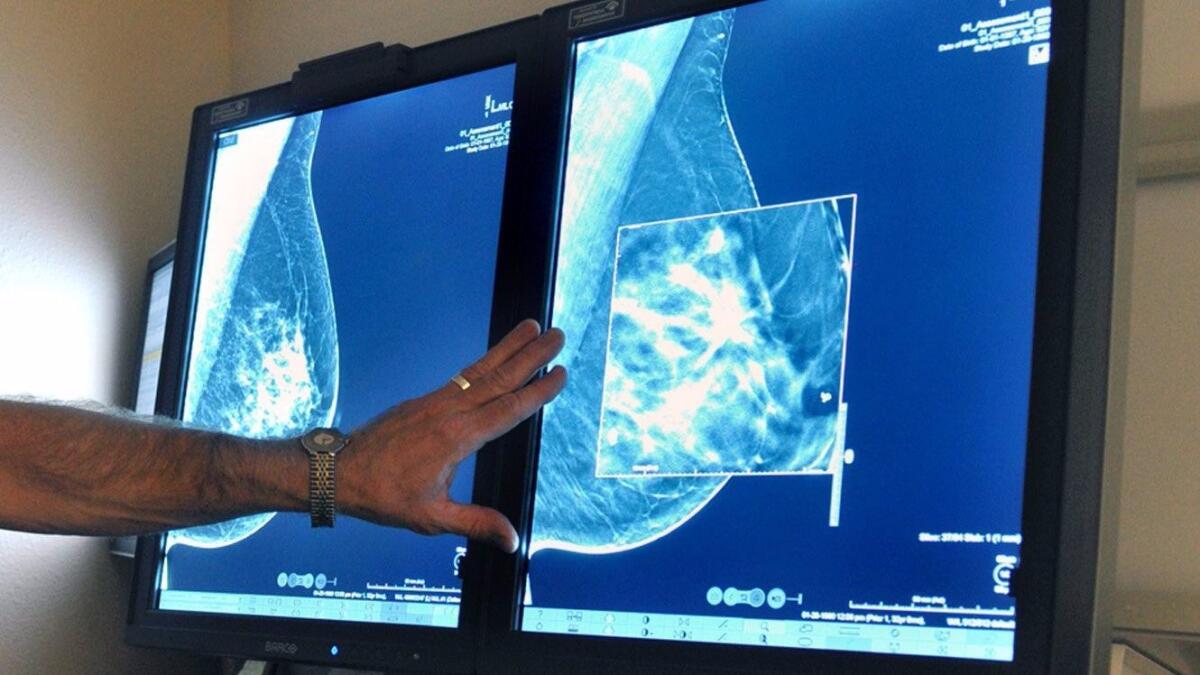Commentary: Breast cancer screening controversy: What you need to know

- Share via
Screening mammograms save lives. There is no controversy there. But how often to screen and at what age? This is where the varying opinions lie.
Two years ago, the American Cancer Society changed mammography recommendations, ruling that for average-risk women, yearly mammograms should start at age 45, not 40, and transition to every other year beginning at age 55.
This is in contrast to the longstanding recommendations of the National Comprehensive Cancer Network and the American College of Radiology who maintain that annual mammograms starting at age 40 are the standard of care.
A new study published in the journal “Cancer” sheds new light on these disparate guidelines with hard numbers. The study by Dr. Elizabeth Arleo and her colleagues found that yearly mammograms between the ages of 40 and 84 would cut breast cancer deaths by 40% , compared to a 31% mortality reduction with the new ACS guidelines.
The study also looked at the most recent United States Preventive Services Task Force guidelines, which recommend biennial screening between the ages of 50 and 74. The USPSTF model found a mortality reduction of only 23%.
Despite inconsistencies in various screening guidelines, most organizations agree in the importance of shared decision making and “individual values.” Arleo’s study is just the latest evidence demonstrating that women who value their lives above all, should have yearly screening mammograms, starting at age 40.
The facts about breast cancer are scary. One in eight women will develop breast cancer in her lifetime. One in 69 will be diagnosed in her 40s. Over the last 10 years, Hoag Hospital has diagnosed and/or treated 1,162 cancers in women between the ages of 40-49, and 464 of those cancers were in women between the ages of 40-44.
The scariest fact is that, despite advancements in treatment, breast cancer remains the second leading cause of cancer death in women.
In addition to saving lives, early detection often results in breast conserving surgery, better cosmetic results, lower treatment costs and potentially avoiding chemotherapy and radiation. Without yearly mammograms, self-exams and clinical breast examinations (which the ACS also recommends against), early detection is virtually impossible.
Women should be encouraged to seek out improved screening and more effective and tailored treatments. Breast Tomosynthesis, or 3D mammography, for instance, has been found to increase the detection of invasive cancer by up to 40%, while simultaneously reducing the rate of false positives. Couple this with highly skilled, dedicated breast radiologists, and women experience less anxiety and fewer biopsies.
Tens of thousands of women between the ages of 40 and 44 will develop breast cancer this year. Without screening mammograms and breast exams, how or when would these women be diagnosed? How many of them could die because of a delayed diagnosis? It’s time to improve breast cancer screening, not suppress it. The lives of countless mothers, sisters, wives and friends depend upon it.
DR. JANUARY LOPEZ is the director of Breast Imaging at Hoag Breast Center.
All the latest on Orange County from Orange County.
Get our free TimesOC newsletter.
You may occasionally receive promotional content from the Daily Pilot.



